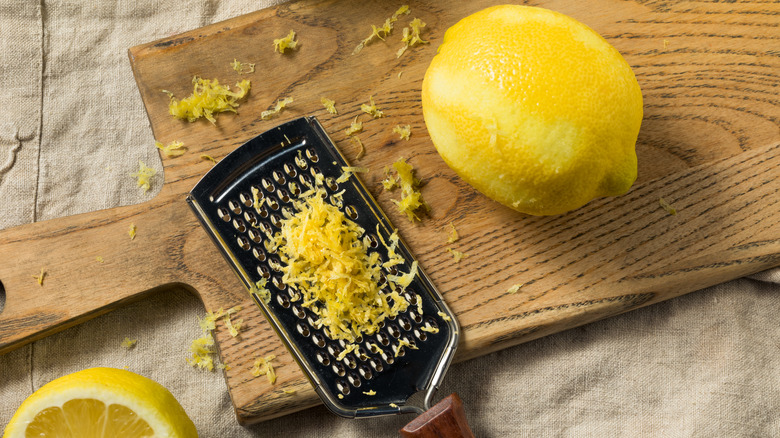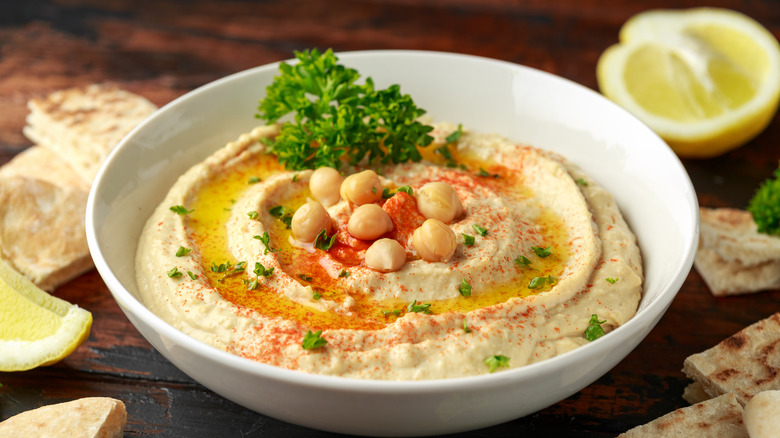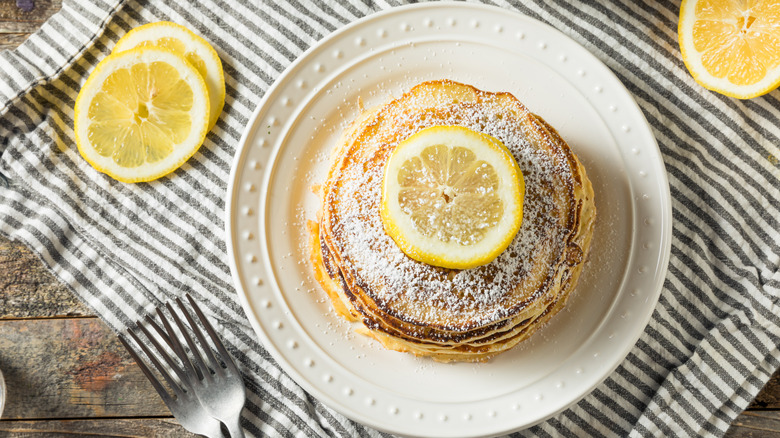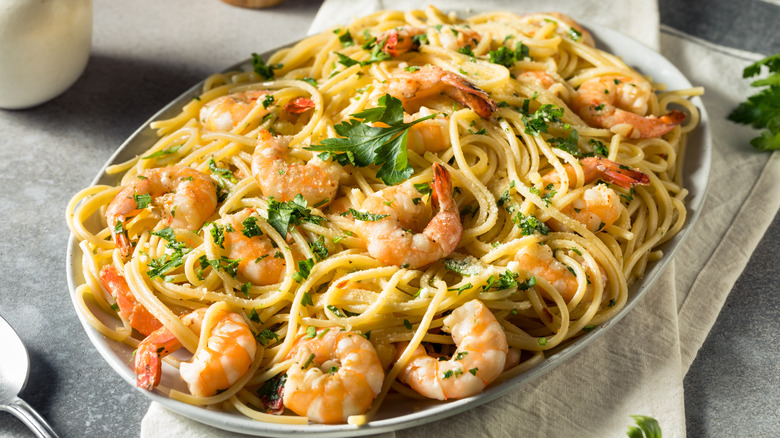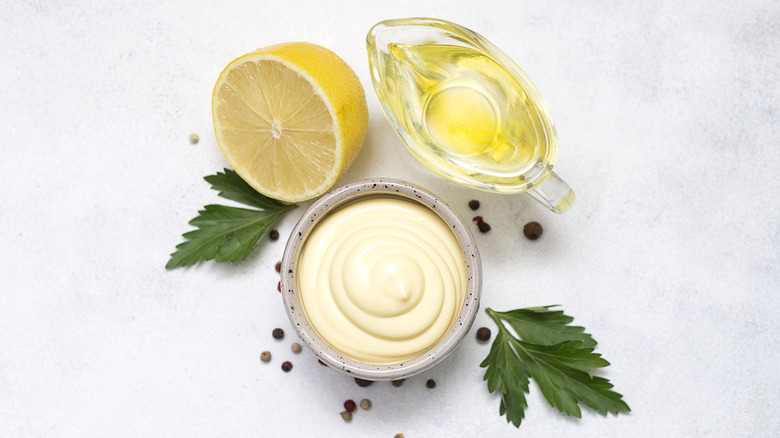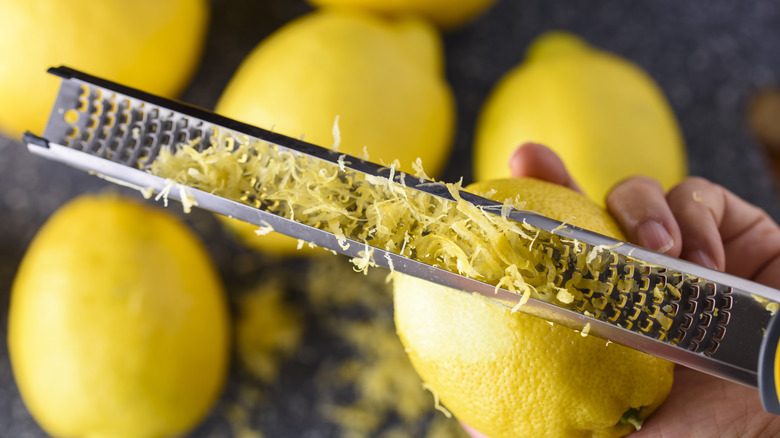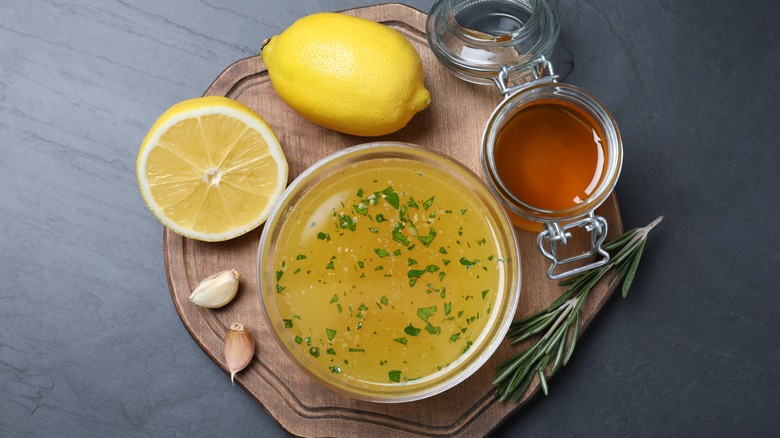What Is Lemon Zest And How Do You Use It?
There are tons of good reasons to keep fresh lemons around. Whether it's making a quick pitcher of some simple homemade lemonade or a citrusy batch of lemon herb shrimp, this bright and shiny yellow fruit can work wonders on everything from refreshing drinks to a wide range of delicious meals. And while many people know a few ways to take advantage of a lemon slice's juicy interior, there's an equally beneficial resource right there on its outer skin that's often tragically neglected by home cooks: The mighty lemon peel. I'm here on a mission to change that and convince you that lemon peels are absolutely worth using on a regular basis.
Lemon zest is the outermost skin of raw lemon peels. The peel of the lemon is gently grated with a microplane (also referred to as a zester) which shreds the lemon skin into thin strands of zest. Try and be mindful of how deep you're grating — you really just want the thin yellow skin that's on the outermost surface of the lemon. If you go any deeper, you'll burrow into the pith, which is the white flesh between the yellow peel and the fruit. The problem here is that the pith has a bitterness that's not exactly appetizing, so it's best avoided. Instead, focus on grating only the topmost layer of the lemon skin — the yellowest part of the peel. Read on for some ideas to get you started.
Add it to hummus
Hummus is a Middle Eastern dip that's typically made with mashed chickpeas (garbanzo beans), tahini, garlic, salt, and lemon juice. It's often garnished with a drizzle of olive oil, a sprinkle of paprika, and some fresh herbs, and has a rich, earthy flavor that's best enjoyed on pieces of warm pita bread, in sandwiches, or whipped into a salad dressing. Of course, making hummus from scratch tends to give a much better taste than the store-bought varieties. That said, there's no denying the convenience of store-bought hummus — and if you have a fresh lemon on hand at home, you can jazz it up in a jiffy.
The next time you pop open a tub of pre-made hummus from the grocery store, try zesting a lemon over it. The zest will add a level of lemony freshness that store-bought hummus tends to lack. Considering zesting a lemon takes minimal time and effort, it's well worth the investment, and your hummus will reward you with a deliciously vibrant pop of citrus. You also might also want to squeeze a little fresh lemon juice into the hummus while you're at it.
Pump up your pancakes
Another great way to incorporate lemon zest is by adding it to pancakes. This pairs particularly well with blueberry pancakes. When you're dropping your fresh blueberries into the pancake batter while you're cooking them on the griddle, grate some lemon zest over the pancakes too. After you flip them and put them on a dish, grate a little more lemon zest over the plate for some extra flavor and visual appeal. You'd be surprised how much more appetizing those bright yellow specks of lemon make the pancakes look. The fresh citrus of lemon and tangy sweetness of blueberries combine to form a delightful stack of pancakes that will take your breakfast to the next level.
If you're in the mood for something more savory, try adding some zest to a batch of lemon ricotta pancakes. Mix the lemon zest with sugar, ricotta, buttermilk, eggs, vanilla, and vegetable oil. Then add a mixture of flour, baking powder, and salt to the bowl of ricotta-buttermilk mixture. When the pancakes are cooked and plated, garnish them with a little powdered sugar and a dash of extra zest.
Bump up your batter
Batter is a great way to coat everything from fried fish and onion rings to crispy shrimp and fried mushrooms. All it really takes is a little flour, cornstarch, seasoning, egg, and a splash of beer and you're in business. No matter how golden brown and crispy you cook them, fried food still has an inherent heaviness to it — that's the inescapable nature of submerging food in a vat of piping hot fat. This is a big reason why so many fried foods are served with fresh lemon wedges; lemons help cut through the richness of the salt and fat to brighten up an otherwise heavy dish. But there's another way to lift up those flavors before your food has even been cooked.
It all comes down to adding fresh lemon zest directly to the batter itself. The next time you're whipping up some batter, try adding fresh zest in with all of your other seasonings, so it can release its oils into the batter, infusing it with flavor. This pairing works especially well with any dishes that you'd normally squeeze some fresh lemon onto after they've been cooked, like crab cakes or fish and chips. Adding lemon zest directly to your batter gives it some subtle lemony complexity that bumps up its deliciousness. Of course, you should still save some lemon juice to squeeze over it after it's been cooked too. Using these two additions together creates another layer of flavor.
Add it to pasta
There's something comforting and satisfying about a steaming bowl of pasta. If you're anything like us, you probably make some type of pasta for dinner on a fairly regular basis, and the truth is that no matter what kind of pasta you're making, there's a good chance that it could benefit from a little lemon zest somewhere along the way.
One of the best ways to enjoy a burst of citrus is with lemon-garlic shrimp pasta. After cooking the shrimp in garlic butter and the mixing the pasta with spinach, parmesan, red pepper flakes, and parsley, toss everything together and then squeeze a little lemon juice over the top and add some grated lemon zest too. Each forkful of this pasta is creamy and garlicky and the bursts of lemon perfectly complement the shrimp and the sauce.
If you're aiming for something even easier, try adding some fresh lemon zest (along with just a little lemon juice) to some store-bought pesto sauce. The added lemon brings the pre-made pesto back to life. Because pesto made from scratch often contains lemon, adding some zest and juice to store-bought pesto feels like a shortcut to enjoying something that still tastes homemade.
Make better mayo
The next time you're making a sandwich, try adding some fresh lemon zest to your mayo. On its own, mayo is creamy and oily with a subtle tang, but, when you introduce some lemon zest into the mix, it takes on a much brighter flavor. Let the mix of mayo and lemon rest for at least 30 minutes in the fridge, to let the zest mingle long enough to infuse. Add a pinch of salt, pepper, and paprika to amplify the flavors.
Swap in this lemony mayo on anything you'd normally use regular mayonnaise for. BLTs, tuna melts, turkey sandwiches, chicken wraps, spinach dip, Mexican street corn — the sky's the limit. It's amazing how the addition of something so small can make such a huge difference and pack such a big punch of flavor. In just a flash, a little zest has the ability to transform the mundane into something bright and delectable.
Improve rubs and marinades
At a bare minimum, a simple rub typically consists of salt and pepper. Additional ingredients, like garlic powder, paprika, dried oregano, chili powder, sugar, and ground ginger, are also frequently added to the mix for a more well-rounded all-purpose seasoning blend. To take your seasoning rubs to the next level, try stirring in some lemon zest. You may want to also add a little neutral oil so that the seasoning and lemon zest can mingle together better. The lemon zest will add its distinctive fruity flavor to the seasoning and it can be rubbed on everything from pork and chicken to shrimp and tofu.
Lemon zest can be added to a liquid marinade for a similar effect. A simple yet popular marinade often consists of soy sauce, olive oil, garlic, pepper, and a little bit of brown sugar along with a dash of lemon juice. This is a yet another great opportunity to maximize that lemon flavor by not letting your lemon skin go to waste, so bust out your grater and add a little lemon zest into your marinade too.
Brighten up your salad dressing
The heart and soul of every salad largely depend upon the quality of its dressing. Without a good salad dressing, all you're left with is a bowl of plain vegetables. While that certainly might be nutritious, your taste buds won't exactly be enrapt with pleasure. And let's face it: The reason we're all gathered here today is to open up our minds to more possibilities of edible bliss. Adding lemon zest to your salad dressing can do that.
The beauty of this is that adding lemon zest can work for homemade salad dressing and also for store-bought salad dressing. There's no doubt that store-bought is the easiest option, but the truth is that making a delicious salad dressing from scratch is actually quite easy, and doesn't take much time. This lemon vinaigrette combines salt and pepper, garlic, red pepper flakes, extra virgin olive oil, and lemon juice to form a simple but tasty salad dressing that works on an assortment of greens. Kick the recipe up a notch by adding some fresh lemon zest into the mix.
Add it to baked goods
Whether you're making cookies, cupcakes, or muffins, there's a good chance that they could benefit from the refreshing lift of some citrussy lemon zest. Some tasty options include adding lemon zest to the frosting for sugar cookies, vanilla cupcakes, and blueberry muffins. You can also try adding some directly to the batter during the mixing process so that the lemon flavor is more even throughout.
Like the other suggestions on this list, the lemon zest doesn't necessarily have to be added to only homemade baked goods. You can also doctor up some store-bought desserts with lemon zest, like pre-made frosting. You can even just grate some lemon zest over pre-made cakes in the bakery section for some extra flavor — this can work particularly well for pineapple upside-down cake, poke cake, and strawberry shortcake. The bottom line is, there's no shortage of options when it comes to pairing lemon zest with sweet treats.
Use it in cocktails
A lot of cocktails use lemons in the recipe. Sometimes they use lemon juice, sometimes a twist of lemon is added to the drink, and other times a lemon peel may be lightly rubbed along the rim of the glass to express its natural oils for a more subtle flavor. Aspiring mixologists who enjoy the taste of lemon may also want to experiment with adding some lemon zest to their cocktail shakers.
Adding lemon zest to the drink gives the cocktail a nice lemony flavor without all of the extra acidity that comes with only using the juice, giving the brightness of citrus without excessive sourness. Try adding a touch of lemon zest to margaritas, whiskey sours, Long Island iced teas, or mojitos. If you happen to have limes on hand instead, you can always add in a dash of lime zest for a similar effect.
Freeze it into ice cubes
If you find yourself in a situation where you have more lemons than you know what to do with, try not to let them go to waste. If you have a little extra time and some ice cube trays, you can put those lemons to good use by freezing them. Grate the lemon peels into zest, then spoon the zest into an ice cube tray. Rather than filling it with water, you can squeeze all those fresh lemons and juice them over the zest. Store the zesty lemon juice in the freezer, and then pop out your cubes as needed for a healthy and refreshing drink. These can be used to freshen up some good old-fashioned lemonade or added to cocktails.
Of course, you can also just let some of the lemon cubes thaw out later on for use in cooking. This can be a good option for when you want to add lemon to sauces, dressings, and marinades. The next time you have some fresh lemons on hand in the kitchen, be sure to show the peels some love and utilize their zest — your tastebuds will thank you.
